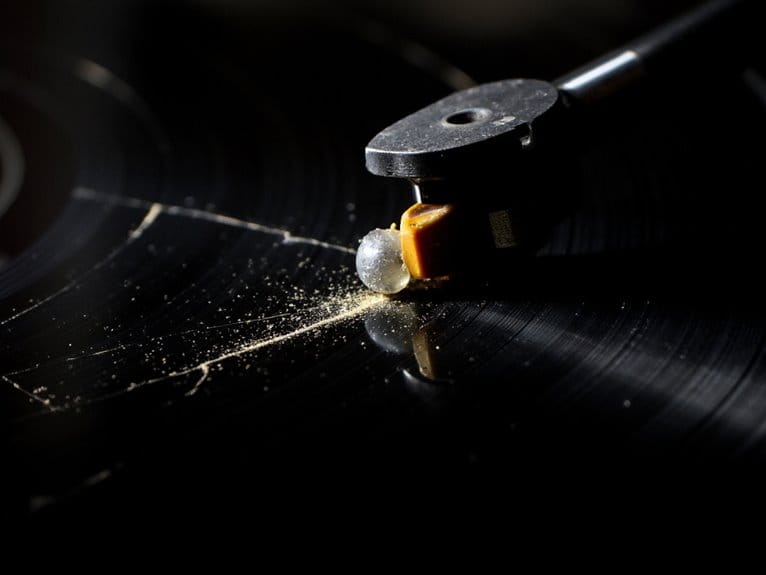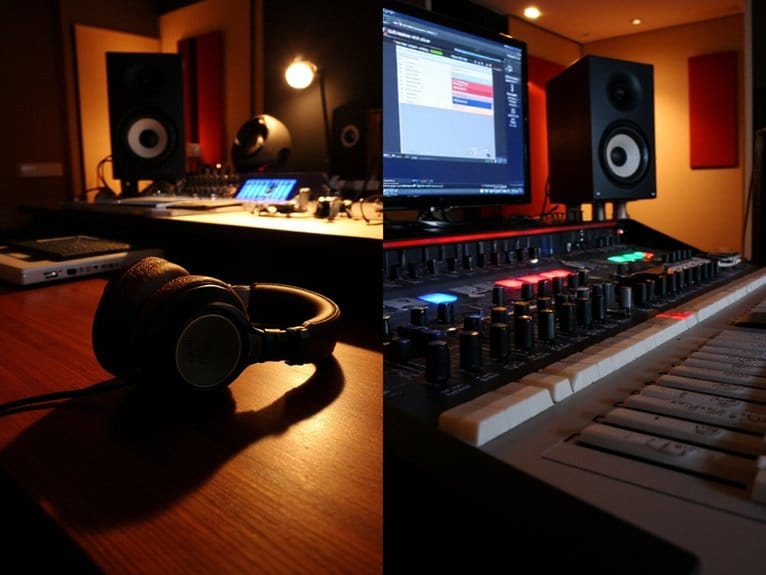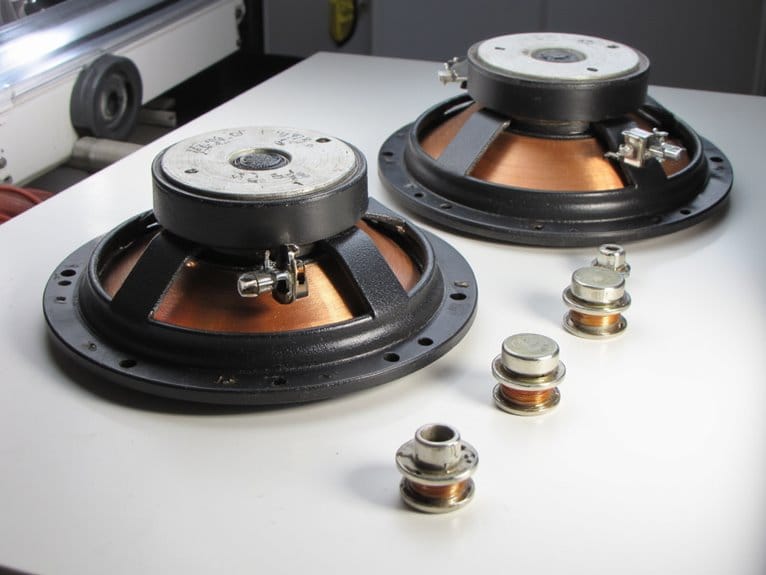Drum Machines for Songwriters and Producers
You’ll find that modern drum machines range from $99 portable units to $2,000 studio workstations, offering everything from analog warmth to precise digital sampling. Whether you’re crafting hip-hop beats with TR-808-style bass drums or programming complex polymetric patterns, these tools provide step sequencing, parameter locks, and built-in effects that streamline your workflow. The best mid-range options ($300-$800) deliver professional sound quality with MIDI connectivity, making them accessible for bedroom producers while offering the tactile control and sonic versatility that’ll transform how you approach beat-making.
We are supported by our audience. When you purchase through links on our site, we may earn an affiliate commission, at no extra cost for you. Learn more.
Notable Insights
- Mid-range drum machines ($300-$800) offer the best price-performance ratio for songwriters seeking professional quality without major investment.
- Step sequencing with parameter locks and probability features enables dynamic beat creation while avoiding mechanical-sounding repetitive patterns.
- Hybrid machines like IK Multimedia UNO Drum combine analog warmth with digital precision for versatile sound design capabilities.
- MIDI connectivity and DAW integration allow seamless workflow between hardware tactile control and software-based music production projects.
- Genre-specific applications range from TR-808’s hip hop bass drums to TR-909’s techno influence, making machine selection crucial for sound.
Types of Drum Machines for Modern Music Production
When you’re diving into the world of drum machines for songwriting, understanding the fundamental differences between analog, digital, and hybrid machines becomes essential for making informed decisions that’ll shape your creative workflow.
Analog machines deliver those warm, punchy tones through synthesis circuits, though they typically offer less sound variability than their digital counterparts.
Digital machines provide precise sample manipulation and complex sequencer design capabilities, while portable units like the Korg Volca Drum excel at mobile production without sacrificing sophisticated features.
Hybrid machines combine both worlds, offering diverse sonic palettes—the IK Multimedia UNO Drum features five analog and seven PCM sounds. Modern drum machines often incorporate probability sequencing for creating organic and unpredictable rhythmic variations that add human feel to programmed beats.
For live performance, compact battery-powered models facilitate on-the-go creativity, though you’ll sometimes compromise connectivity options for portability’s convenience. Professional units like the Elektron Analog Rytm MKII offer velocity-sensitive pads with aftertouch capabilities for more expressive and dynamic performance control.
Essential Features That Shape Your Creative Workflow
When you’re selecting a drum machine that’ll actually enhance your songwriting process, three core features determine whether you’ll create effortlessly or struggle against clunky workflows that kill your creative momentum.
Your sequencing and pattern programming capabilities dictate how quickly you can translate rhythmic ideas from your head into tangible beats, while sound design features let you craft drum tones that perfectly complement your musical vision rather than settling for generic presets.
The hardware integration options you choose will either seamlessly connect your drum machine to your existing setup, creating a unified creative environment, or leave you wrestling with compatibility issues that interrupt your flow every time inspiration strikes. Built-in effects like reverb and delay expand your sonic palette, allowing you to shape drum sounds that sit perfectly in your mix without requiring additional processing.
Sequencing and Pattern Programming
While flashy sounds and premium samples might catch your attention first, the sequencing engine truly determines whether a drum machine will enhance or hinder your creative process.
Step sequencing forms the foundation, dividing patterns into fixed steps where you’ll program hits across a grid representing different drum sounds and time divisions. Modern machines elevate this basic framework with parameter locks that let you automate filter sweeps, pitch changes, and sample switching per step, transforming static loops into evolving arrangements.
Polymetric patterns emerge when different drum channels run at varying lengths, creating rhythmic complexity that shifts with each repetition. Probability features add human-like variation by triggering hits based on programmed percentages, preventing the mechanical repetition that often plagues programmed beats and keeping your arrangements fresh.
Sound Design Capabilities
How you shape and sculpt your drum sounds determines whether your tracks sound professional or amateurish, making sound design capabilities the most critical factor I consider when evaluating drum machines for serious songwriting work.
Modern units employ two core synthesis techniques: pure synthesis using oscillators and filters, or sampling methods that playback recorded audio.
I’ve found hybrid machines offer the most versatility, combining both approaches for extensive sound customization. Essential features include precise envelope shaping with adjustable attack, decay, sustain, and release parameters that control how each hit articulates.
Advanced modulation effects create dynamic variation through automated parameter changes, while integrated processing like multimode filters, compressors, and overdrive provide advanced effects for professional-grade sound sculpting that transforms basic patterns into polished productions.
Hardware Integration Options
Three fundamental integration categories determine how effectively a drum machine will mesh with your existing studio setup, and I’ve learned that overlooking any of these areas can create frustrating bottlenecks that derail creative momentum.
Hardware compatibility starts with your connection methods—MIDI clock sync keeps everything locked in tempo, while USB connectivity streamlines audio transfer to your DAW. You’ll want multiple physical outputs for flexible routing, whether that’s individual drum outs for mixing or main outputs for live performance.
Audio interface integration becomes essential here, with 24-bit/96 kHz specs ensuring professional quality. I’ve found that bidirectional MIDI I/O handles the heavy lifting for note data and CC messages, creating seamless hybrid workflows between your hardware and software instruments.
For expanded control capabilities, consider how your drum machine will interface with mixing consoles, as many producers find that connecting to 16-channel mixers provides the input capacity and routing flexibility needed for complex production setups.
Top-Rated Drum Machines and Their Unique Strengths
Five standout drum machines have earned their reputations through distinct combinations of sound quality, workflow design, and creative capabilities that cater to different songwriter needs and budgets.
The Elektron Analog Rytm MKII represents the pinnacle of analog vs digital fusion, combining eight-voice analog synthesis with sample playback through velocity-sensitive pads.
For pure digital versatility, the Elektron Digitakt offers 1GB sample memory with parameter locks enabling evolving patterns.
Roland’s TR-8S delivers classic drum emulations alongside modern FM synthesis, while Korg’s Volca Drum provides budget-friendly digital percussion synthesis.
Novation’s Circuit stands out for portability factors, offering battery-powered operation with dual polysynths and four-track sampling in one groovebox, making it ideal for mobile songwriting sessions.
For guitarists specifically, the BeatBuddy MINI 2 offers hands-free operation with 200 customizable songs and weighs just 10.6 ounces for easy integration into existing pedalboard setups.
Hardware Vs Software Integration Strategies
While standalone drum machines excel at creating beats, the real magic happens when you seamlessly blend hardware controllers with software engines, creating hybrid workflows that leverage the tactile immediacy of physical pads alongside the vast sound libraries and processing power of modern computers.
You’ll find that modern integrated systems like Native Instruments Maschine address hardware limitations by pairing ultra-sensitive pads with sophisticated software engines.
Though early versions restricted MIDI output to hardware only, this software flexibility becomes essential when you’re working within DAW environments, where VST and AU plugins integrate your drum sounds directly into your recording projects.
Modern DAW integration transforms restrictive hardware-only MIDI into flexible plugin workflows that seamlessly blend drum sounds with recording projects.
The trade-off involves balancing immediate tactile control against the learning curve of proprietary systems, where firmware updates can occasionally leave you waiting for compatibility fixes.
Professional systems like the MASCHINE+ eliminate computer dependency entirely by functioning as a standalone workstation with built-in quad-core processing, offering producers the flexibility to create without being tethered to a laptop.
Budget Considerations and Price Point Analysis
Understanding your budget constraints becomes the foundation for making smart drum machine choices, since the market spans from $99 pocket-sized units to $2,000 studio centerpieces, each tier offering distinct capabilities that directly impact your songwriting workflow.
Budget friendly options like the Teenage Engineering PO-12 Rhythm deliver surprising sonic quality despite their compact form factor, though you’ll sacrifice advanced sequencing and sampling capabilities for affordability.
Mid-range units between $300-$800, including the Roland TR-6S and Novation Circuit Tracks, typically offer the best price performance ratio for most songwriters, balancing essential features with reasonable costs.
High-end machines justify their premium pricing through standalone operation, extensive sampling libraries, and professional-grade sound engines that eliminate the need for additional software investments.
Modern drum machines often feature MIDI connectivity for seamless integration with digital audio workstations and hardware setups, allowing producers to expand their sonic palette without purchasing additional gear.
Similar to affordable audio interfaces, budget drum machines prove that professional sound quality can be achieved without significant financial investment, making them accessible tools for bedroom producers and home studio enthusiasts.
Genre-Specific Applications and Sound Design Impact
Since different musical genres demand distinct rhythmic foundations and sonic characteristics, I’ve observed how drum machines serve as genre-defining tools that shape entire musical movements through their unique sound design capabilities.
The Roland TR-808‘s deep bass drum fundamentally shaped hip hop’s signature sound, while the TR-909’s sampled cymbals catalyzed techno and house music development.
These genre distinctions become apparent when you compare analog machines, which use voltage-controlled oscillators for warm, punchy sounds favored in vintage hip hop, against digital units offering realistic acoustic drum sounds preferred in rock production.
Understanding these production nuances helps you choose appropriate machines, whether you need swing rhythms for jazz, powerful acoustic emulation for rock, or programmable synthesis for EDM’s intricate, dancefloor-ready beats.
Frequently Asked Questions
Can I Use Multiple Drum Machines Simultaneously in One Setup?
You can definitely use multiple drum machines together by employing proper syncing techniques like MIDI clock or DIN sync. This setup offers significant workflow enhancement, allowing you to layer diverse sounds and create more complex rhythmic textures.
Which Drum Machines Work Best for Live Performance Versus Studio Recording?
For live performance, you’ll want Roland TR-8S or Korg Volca Beats with hands-on controls and portability. For studio recording, choose Elektron Analog Rytm MKII offering superior sound fidelity and detailed sequencing capabilities.
On a final note
You’ve got the knowledge now to make an informed decision about drum machines that’ll serve your creative vision. Whether you’re leaning toward hardware for that tactile experience, or software for maximum flexibility, the key is matching your workflow needs with your budget reality. Don’t overthink it—start with what you can afford, learn the fundamentals, and upgrade as your skills and requirements evolve naturally.





